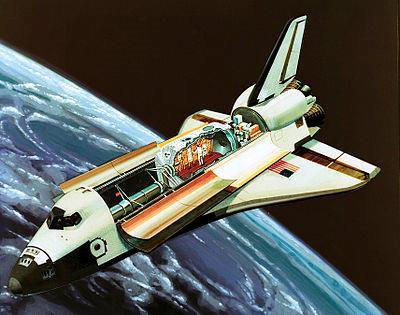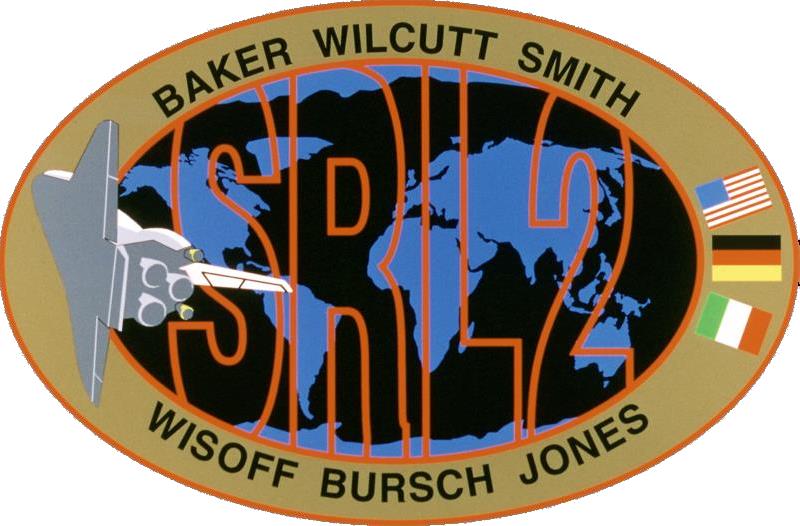Spacelab 021 - STS-68
Mission Name: SLR-2
Astronauts:
Command Pilot:
Michael A. Baker
(Third Space Flight)
Pilot:
Terrance W. Wilcutt
(First Space Flight) Mission Specialist 1:
Thomas D. Jones
(Second Space Flight) Payload Commander Mission Specialist 2:
Steven L. Smith
(First Space Flight)
Mission Specialist 3:
Daniel W. Bursch
(Second Space Flight)Mission Specialist 4:
Peter J.K Wisoff
(Second Space Flight)
Spacelab was a reusable laboratory used on certain spaceflights flown by the Space Shuttle. The laboratory comprised multiple components, including a pressurized module, an unpressurized carrier and other related hardware housed in the Shuttle's cargo bay. The components were arranged in various configurations to meet the needs of each spaceflight.
Spacelab components flew on 22 Shuttle missions between November 1983 and April 1998. Spacelab allowed scientists to perform experiments in microgravity in Earth orbit.
STS-68 marked second flight in 1994 of Space Radar Laboratory (first flight was STS-59 in April), part of NASA's Mission to Planet Earth. Flying SRL during different seasons allowed comparison of changes between first and second flights. SRL-2 was activated on flight day one, and around-the-clock observations conducted by astronauts split into two teams. Besides repeating data takes over same locations as on first flight, unusual events also imaged, including erupting volcano in Russia and islands of Japan after earthquake there. Also tested was ability of SRL-2 imaging radars, Spaceborne Imaging Radar-C (SIR-C) and X- band Synthetic Aperture Radar (X-SAR), to discern difference between such human-induced phenomena as an oil spill in the ocean and naturally occurring film.
Mission also took advantage of opportunity to study fires set in British Columbia, Canada, for forest management purposes. Special readings were taken with another SRL element, Measurement of Air Pollution from satellites (MAPS), to gain better understanding of carbon monoxide emissions from burning forest. Flying for fourth time on the shuttle, MAPS is designed to measure global distribution of carbon monoxide.
On flight day six, mission extended one day by Mission Management Team. The maneuvering capability of the orbiter was demonstrated anew in the latter half of mission, when different data-gathering method was tried. Called interferometry, it required repeated, nearly coincidental imaging passes with SIR-C/X-SAR over target sites. In one instance, Endeavour piloted to within 30 feet (nine meters) of where it was flown on first flight in April. Collected data can be transcribed into detailed topographic images showing elevation and other features. Interferometric passes completed over central North America, Amazon forests of central Brazil, and volcanoes of Kamchatka Peninsula in Russia. Such images, if produced regularly over long term, could provide information on the movements of Earth's surface as small as fraction of an inch, which could be invaluable in detecting pre-eruptive changes in volcanoes and movements in fault lines before earthquakes.
Other cargo bay payloads included five Get Away Specials (GAS): two sponsored by university student groups, one by Swedish Space Corp., and two by U.S. Postal Service holding 500,000 commemorative stamps honoring 25th anniversary of Apollo 11.
Middeck payloads: Commercial Protein Crystal Growth (CPCG) to study dynamics of protein crystallization and also to obtain protein crystals large enough to allow structural analysis; Biological Research in Canisters (BRIC-01), flying for first time and holding gypsy moth eggs to determine how microgravity affects moth development; CHROMEX-05, fifth in series designed to examine effects of microgravity on physiological processes in plants. Previous CHROMEX flights have shown that plants grown in space may not produce seed embryos; CHROMEX-05 designed to show whether infertility is due to microgravity or another environmental factor. Also in middeck: Cosmic Radiation Effects and Activation Monitor (CREAM), to collect data on cosmic rays; and Military Applications of Ship Tracks (MAST), part of five-year Navy effort to study effects of ships on marine environment.
Problems included a missing tile around overhead window; suspect temperature sensor on the orbiter Reaction Control System (RCS) vernier thruster, which led to temporary cessation of SRL-2 radar observations; and failed primary RCS thruster.
Spacelab Space Missions
Study Research
Space Cosmology
Science Research
*
About
Science Research
Science Theories
Site Map
BookShelf
Desk
Copyright © by Nigel G Wilcox · All Rights reserved · E-Mail: ngwilcox100@gmail.com
Designed by Nigel G Wilcox
Powered By AM3L1A
Pages within this section: Spacelab 01-32
Spacelab C21-30
Sub-Menu
21
M
menu
22
23
24
25
26
27
8
29
30
28
>>>
D
SM
C









